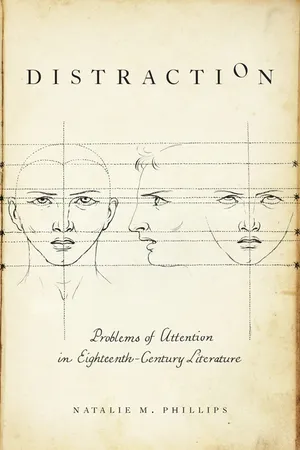
- English
- ePUB (mobile friendly)
- Available on iOS & Android
About this book
Enlightenment writers fiercely debated the nature of distraction in literature.
Early novel reading typically conjures images of rapt readers in quiet rooms, but commentators at the time described reading as a fraught activity, one occurring amidst a distracting cacophony that included sloshing chamber pots and wailing street vendors. Auditory distractions were compounded by literary ones as falling paper costs led to an explosion of print material, forcing prose fiction to compete with a dizzying array of essays, poems, sermons, and histories. In Distraction, Natalie M. Phillips argues that prominent Enlightenment authors—from Jane Austen and William Godwin to Eliza Haywood and Samuel Johnson—were deeply engaged with debates about the wandering mind, even if they were not equally concerned about the problem of distractibility.
Phillips explains that some novelists in the 1700s—viewing distraction as a dangerous wandering from singular attention that could lead to sin or even madness—attempted to reform diverted readers. Johnson and Haywood, for example, worried that contemporary readers would only focus long enough to "look into the first pages" of essays and novels; Austen offered wry commentary on the issue through the creation of the daft Lydia Bennet, a character with an attention span so short she could listen only "half-a-minute." Other authors radically redefined distraction as an excellent quality of mind, aligning the multiplicity of divided focus with the spontaneous creation of new thought. Laurence Sterne's Tristram Shandy, for example, won audiences with its comically distracted narrator and uniquely digressive form.
Using cognitive science as a framework to explore the intertwined history of mental states, philosophy, science, and literary forms, Phillips explains how arguments about the diverted mind made their way into the century's most celebrated literature. She also draws a direct link between the disparate theories of focus articulated in eighteenth-century literature and modern experiments in neuroscience, revealing that contemporary questions surrounding short attention spans are grounded in long conversations over the nature and limits of focus.
Frequently asked questions
- Essential is ideal for learners and professionals who enjoy exploring a wide range of subjects. Access the Essential Library with 800,000+ trusted titles and best-sellers across business, personal growth, and the humanities. Includes unlimited reading time and Standard Read Aloud voice.
- Complete: Perfect for advanced learners and researchers needing full, unrestricted access. Unlock 1.4M+ books across hundreds of subjects, including academic and specialized titles. The Complete Plan also includes advanced features like Premium Read Aloud and Research Assistant.
Please note we cannot support devices running on iOS 13 and Android 7 or earlier. Learn more about using the app.
Information
Table of contents
- Cover
- Title Page
- Copyright Page
- Contents
- Preface
- Introduction: The Literary History of Distraction
- 1 Mind Wandering: Forms of Distraction in the Eighteenth-Century Essay
- 2 Lapses of Concentration: Distracted Vigilance and the Female Mind
- 3 Scattered Attention: Distraction and the Rhythm of Cognitive Overload
- 4 Fixated Attention: The Gothic Pathology of Single-Minded Focus
- 5 Divided Attention: Characterization and Cognitive Richness in Jane Austen
- Coda: History of Mind and Literary Neuroscience
- Notes
- Bibliography
- Index